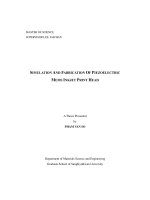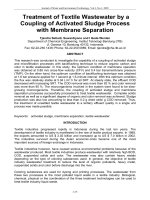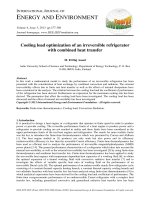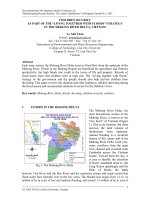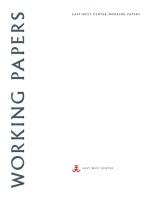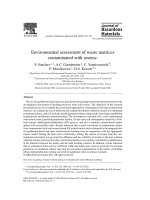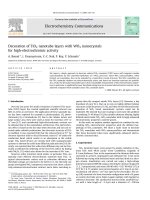vFacile Fabrication of Uniform Polyaniline Nanotubes with Tubular Aluminosilicates as Templates" pptx
Bạn đang xem bản rút gọn của tài liệu. Xem và tải ngay bản đầy đủ của tài liệu tại đây (297.11 KB, 4 trang )
NANO EXPRESS
Facile Fabrication of Uniform Polyaniline Nanotubes
with Tubular Aluminosilicates as Templates
Long Zhang Æ Peng Liu
Received: 28 July 2008 / Accepted: 4 August 2008 /Published online: 17 August 2008
Ó to the authors 2008
Abstract The uniform polyaniline (PANI) nanotubes,
with inner diameter, outer diameter, and tubular thick-
ness of 40, 60, and 10 nm, respectively, were prepared
successfully by using natural tubular aluminosilicates as
templates. The halloysite nanotubes were coated with
PANI via the in situ chemical oxidation polymerization.
Then the templates were etched with HCl/HF solution.
The PANI nanotubes were characterized using FTIR,
X-ray diffraction, and transmission electron microscopy.
The conductivity of the PANI nanotubes was found to be
1.752 9 10
-5
(XÁcm)
-1
.
Keywords Polyaniline nanotube Á Fabrication Á
Halloysite nanotube Á Template
Introduction
Conducting polymer nanotubes have recently become the
object of numerous investigations because of their great
potential in device applications, such as transistors [1],
sensors [2], actuators [3], batteries [4], and so on. The
conducting polymer nanotubes can be chemically or
electrochemically synthesized by the ‘‘soft’’ and ‘‘hard’’
template method. In the first approaches, the micelles or
assemblies produced by the salts of the organic acids
(such as naphthalenesulfonic acids [5], camphorsulfonic
acid [6], 2-acrylamido-2-methyl-1-propanesulfonic acid
[7], sulfoxy-terminated dendrons [8], and polymeric acids
[9]) and aniline act as the ‘‘soft’’ templates. The poly-
merization at template interfaces would give rise to
polyaniline (PANI) nanotubes. The inner diameters of
the PANI nanotubes by the ‘‘soft’’ templates were diffi-
cult to control and sometimes the nanofibers or
nanoparticles were by-produced [10, 11].
As for the ‘‘hard’’ template approaches, the suitable
rod-like objects were used as templates for the poly-
merization and growth of polymer films, followed by
template dissolution. The templates for making PANI
nanotubes include track-etched polycarbonate [12–16],
porous alumina [17, 18], manganese oxide nanowires
[19], polymer fibers [20], and glass tubes [21]. The most
remarkable strongpoint of the ‘‘hard’’ template approa-
ches is that the inner diameters of the PANI nanotubes
could be controlled by the sizes of the templates used.
Halloysite (formula: Al
2
Si
2
O
5
(OH)
4
Á 2H
2
O, 1:1 layer
aluminosilicate), a super-fine clay material, often occurs
as an ultramicroscopic hollow tubule with a multi-layer
wall in nature. Recently, it was used as adsorbents [22],
nanocomposites [23], catalyst supports [24], and nano-
templates or nanoscale reaction vessels instead of carbon
nanotubes or boron nitride nanotubes [25].
In the present work, we report a template-based fab-
rication technique for PANI nanotubes with halloysite
nanotubes (HNTs) as template. The HNTs associate the
chemical properties of halloysite tubule’s outermost
surface with the properties of SiO
2
and properties of the
inner cylinder core with Al
2
O
3
. So the PANI nanotubes
were obtained by etching the template with HCl/HF
solution after the PANI layers were coated onto the
template via in situ soapless emulsion polymerization.
L. Zhang Á P. Liu (&)
State Key Laboratory of Applied Organic Chemistry and
Institute of Polymer Science and Engineering, College of
Chemistry and Chemical Engineering, Lanzhou University,
Lanzhou 730000, People’s Republic of China
e-mail:
123
Nanoscale Res Lett (2008) 3:299–302
DOI 10.1007/s11671-008-9155-z
Experimental Section
Materials
The HNTs with 50 nm in diameter, 500 nm in length, and
with 20 nm hollow inner lumen were obtained from
Xuyong County in Sichuan province of China. Aniline
(analytical grade reagent, Xi’an Reagent Co., Xi’an, China)
was freshly distilled reduced under pressure before use.
Concentrated hydrochloric acid (HCl), hydrofluoric acid
(HF), and ammonium persulfate (APS) were analytical
grade reagents received from Tianjin Chemical Co.,
Tianjin, China, and used without further purification as
received. Distilled water was used throughout.
Polyaniline Nanotubes
The polyaniline coated halloysite nanotubes (PANI/
HNTs) hybrids were prepared as reported previously
[26]: HNTs (3.00 g), aniline (1.50 mL), and conc. HCl
(6.00 mL) were mixed into 450 mL water. The mixtures
were irradiated ultrasonically for 30 min. Then 100 mL
of the acidic aqueous solution of APS (containing APS
6.80 g and conc. HCl 1.00 mL) was added dropwise into
the colloidal mixture within 30 min with magnetic stir-
ring in an ice-water bath. And the mixture was stirred
for 12 h with magnetic stirring.
The PANI/HNTs hybrids obtained (1.0 g) were dis-
persed in 100 mL water containing conc. HCl 10 mL
and conc. HF 10 mL with ultrasonic irradiation for
30 min and then immerged overnight. The PANI nano-
tubes produced were washed with water for several times
until neutral and dried under vacuum at 40 °C overnight.
Characterization
The conversion of aniline was calculated from the ele-
mental analysis (EA) of C, N and H, performed on
Elementar vario EL instrument. Bruker IFS 66 v/s infra-
red spectrometer was used for the Fourier transform
infrared (FT-IR) spectroscopy analysis in the range of
400–4000 cm
-1
with the resolution of 4 cm
-1
. The KBr
pellet technique was adopted to prepare the sample for
recording the IR spectra. The XRD patterns were recor-
ded in the range of 2h = 10–80° by step scanning with a
Shimadzu XRD-6000 X-ray diffractometer (Shimadzu
Corp., Kyoto, Japan). Nickel-filter Cu Ka radiation
(k = 0.15418 nm) was used with a generator voltage of
40 kV and a current of 30 mA. The morphologies of the
nanotubes were characterized with a JEM-1200 EX/S
transmission electron microscope (TEM) (JEOL, Tokyo,
Japan). The powders were dispersed in water in an
ultrasonic bath for 5 min, and then deposited on a copper
grid covered with a perforated carbon film. The electrical
conductivity of the PANI nanotube was measured using
SDY-4 Four-Point Probe Meter (Guangzhou Institute of
Semiconductor Materials, Guangzhou, China) at ambient
temperature.
Results and Discussion
The acidic dopants are generally used in order to form
conductive nanostructured PANI (i.e., the emeraldine salt
form) by either the ‘‘hard’’ template or the ‘‘soft’’ tem-
plate methods. As for the HNTs used as the templates in
the present work, they might be destroyed in the HCl
media because of the Al
2
O
3
composition. So the effect of
the medium acidities was investigated in the previous
work [26]. It was found that 6.00 mL conc. HCl was the
maximum amount and the HNTs’ structures were
destroyed with more conc. HCl added. The weight ratio
of the PANI coated with HNTs templates was found to be
43.67%. It indicated that almost all the aniline had been
polymerized to form the coaxial coatings on the outer
surfaces of HNTs templates.
The TEM image of the PANI/HNTs hybrids is shown
in Fig. 1b. It was observed that the diameter of the
PANI/HNTs hybrids increased from *40 nm of the raw
HNTs (Fig. 1a) to about 60 nm. And the inner hollow
cavity of the PANI/HNTs hybrids remained at about
10 nm as the raw HNTs (Fig. 1a). It indicated that the
polyaniline layer with the thickness of about 10 nm was
only coated onto the outer surfaces of the HNTs.
The HNT is a kind of layered aluminosilicate, asso-
ciated with the chemical properties of halloysite tubule’s
outermost surface with the properties of SiO
2
and
properties of the inner cylinder core with Al
2
O
3
. So the
HNTs templates could be etched with HCl/HF solution.
Furthermore, the two acids cannot dissolve the polyani-
line coatings. So the HNTs templates were etched with
HCl/HF solution with ultrasonic irradiation for 30 min
and then immerged overnight. The PANI nanotubes
obtained were analyzed with TEM and the image is
shown in Fig. 1c. The PANI nanotube was found to be
uniform with inner diameter, outer diameter, and shell
thickness of 40, 60, and 10 nm, respectively.
The XRD (Fig. 2) and FTIR (Fig. 3) techniques were
used for testifying the complete removal of the HNTs
templates. After the etching of the templates with HCl/
HF solution, the XRD patterns of the HNTs disappeared
300 Nanoscale Res Lett (2008) 3:299–302
123
(Fig. 2). It indicated that the crystal structures of the
HNTs nanotubes were destroyed. Moreover, in the FTIR
spectrum of the PANI nanotubes, only the PANI absor-
bance remained. All the absorbance peaks (3710, 3650,
1640, 1040, 910, 750, 550, and 460 cm
-1
) disappeared.
It showed that the HNTs templates were removed com-
pletely after the treatment with the mixing acid.
The conductivity of the PANI nanotubes prepared with
the present method was found to be 1.752 9 10
-5
(XÁcm)
-1
. However, the conductivities of the PANI/SNS
nanocomposites were lower than the other popular values
reported. It might due to the release of the acid dopant
during the post-treatments such as washing and drying.
Conclusion
In summary, an efficient approach for the preparation of the
uniform PANI nanotubes was achieved. This method
included the coating of PANI onto the HNTs templates via
the in situ soapless emulsion polymerization and the etch-
ing of the HNTs templates with mixing acid. The uniform
Fig. 1 TEM images: (a)
halloysite nanotubes, (b) PANI/
HNTs hybrids, and (c) PANI
nanotubes
Nanoscale Res Lett (2008) 3:299–302 301
123
PANI nanotubes had the inner diameter, outer diameter, and
tubular thickness of 40, 60, and 10 nm, respectively.
Acknowledgment This project was granted financial support from
the China Postdoctoral Science Foundation (Grant No.
20070420756).
References
1. A.N. Aleshin, Adv. Mater. 18, 17 (2006). doi:10.1002/adma.
200500928
2. M. Kanungo, A. Kumar, A.Q. Contractor, Anal. Chem. 758, 5673
(2003). doi:10.1021/ac034537h
3. R.H. Baughman, Science 308, 63 (2005). doi:10.1126/science.
1099010
4. F.Y. Cheng, W. Tang, C.S. Li, J. Chen, H.K. Liu, P.W. Shen
et al., Chem. Eur. J. 12, 3082 (2006). doi:10.1002/chem.200
500883
5. Z. Zhang, Z. Wei, L. Zhang, M. Wan, Adv. Mater. 14, 1314
(2002). doi:10.1002/1521-4095(20020916)14:18\1314::AID-ADMA
1314[3.0.CO;2-9
6. Y. Long, L. Zhang, Y. Ma, Z. Chen, N. Wang, Z. Zhang et al.,
Macromol. Rapid Commun. 24, 938 (2003). doi:10.1002/marc.
200300039
7. N.J. Pinto, O.L. Carrion, A.M. Ayala, M. Ortiz-Marciales, Synth.
Met. 148, 271 (2005). doi:10.1016/j.synthmet.2004.10.016
8. C. Cheng, J. Jiang, R. Tang, F. Xi, Synth. Met. 145, 61 (2004).
doi:10.1016/j.synthmet.2004.04.004
9. L.J. Zhang, H. Peng, J. Sui, P.A. Kilmartin, J. Travas-Sejdic,
Curr. Appl. Phys. 8, 312 (2008). doi:10.1016/j.cap.2007.10.070
10. H.J. Ding, J.Y. Shen, M.X. Wan, Z.J. Chen, Macromol. Chem.
Phys. 209, 865 (2008). doi:10.1002/macp.200700624
11. J. Stejskal, I. Sapurina, M. Trchova, E.A. Konyushenko, P.
Holler, Polymer (Guildf) 47, 8253 (2006). doi:10.1016/j.polymer.
2006.10.007
12. C.R. Martin, Science 266, 1961 (1994). doi:10.1126/science.266.
5193.1961
13. M. Delvaux, J. Duchet, P. Stavaux, R. Legras, S. Demoustier-
Champagne, Synth. Met. 113, 275 (2000). doi:10.1016/S0379-
6779(00)00226-5
14. M. Kanungo, A. Kumar, A.Q. Contractor, Anal. Chem. 75, 5673
(2003). doi:10.1021/ac034537h
15. B. Palys, P. Celuch, Electrochim. Acta 51, 4115 (2006). doi:
10.1016/j.electacta.2005.11.030
16. M. Mazur, M. Tagowska, B. Palys, K. Jackowska, Electrochem.
Commun. 5, 403 (2003). doi:10.1016/S1388-2481(03)00078-X
17. C.R. Martin, Acc. Chem. Res. 28, 61 (1995). doi:10.1021/
ar00050a002
18. S.M. Yang, K.H. Chen, Y.F. Yang, Synth. Met. 152, 65 (2005).
doi:10.1016/j.synthmet.2005.07.142
19. L.J. Pan, L. Pu, Y. Shi, S.Y. Song, Z. Xu, R. Zhang et al., Adv.
Mater. 19, 461 (2007). doi:
10.1002/adma.200602073
20. H. Dong, S. Prasad, V. Nyame, W.E. Jonesm Jr, Chem. Mater.
16, 371 (2004). doi:10.1021/cm0347180
21. Y. Gao, S. Yao, L.Y. Qu, Macromol. Rapid Commun. 28, 286
(2007). doi:10.1002/marc.200600672
22. M.F. Zhao, P. Liu, Microporous Mesoporous Mater. 112, 419
(2008). doi:10.1016/j.micromeso.2007.10.018
23. M.F. Zhao, P. Liu, J. Macromol. Sci. B Phys. 46, 891 (2007)
24. P. Liu, M.F. Zhao, Appl. Surf. Sci. (2008), revised
25. D.G. Shchukin, G.B. Sukhorukov, R.R. Price, Y.M. Lvov, Small
1, 510 (2005). doi:10.1002/smll.200400120
26. L. Zhang, T.M. Wang, P. Liu, Appl. Surf. Sci. (2008), in press
4000 3500 3000 2000 1500 1000 500
0
20
40
60
80
100
120
PANI nanotubes
PANI/HNTs
HNTs
Absorbance (%)
Wavenumber (cm
-1
)
Fig. 3 FT-IR spectra of the HNT templates, PANI/HNTs hybrids,
and PANI nanotubes
15 30 45 60 75
0
50
100
150
200
250
300
350
PANI nanotubes
PANI/HNTs
HNTs
I(CPS)
Theta-2Theta (deg)
Fig. 2 XRD patterns of raw HNTs, PANI/HNTs hybrids, and PANI
nanotubes
302 Nanoscale Res Lett (2008) 3:299–302
123

